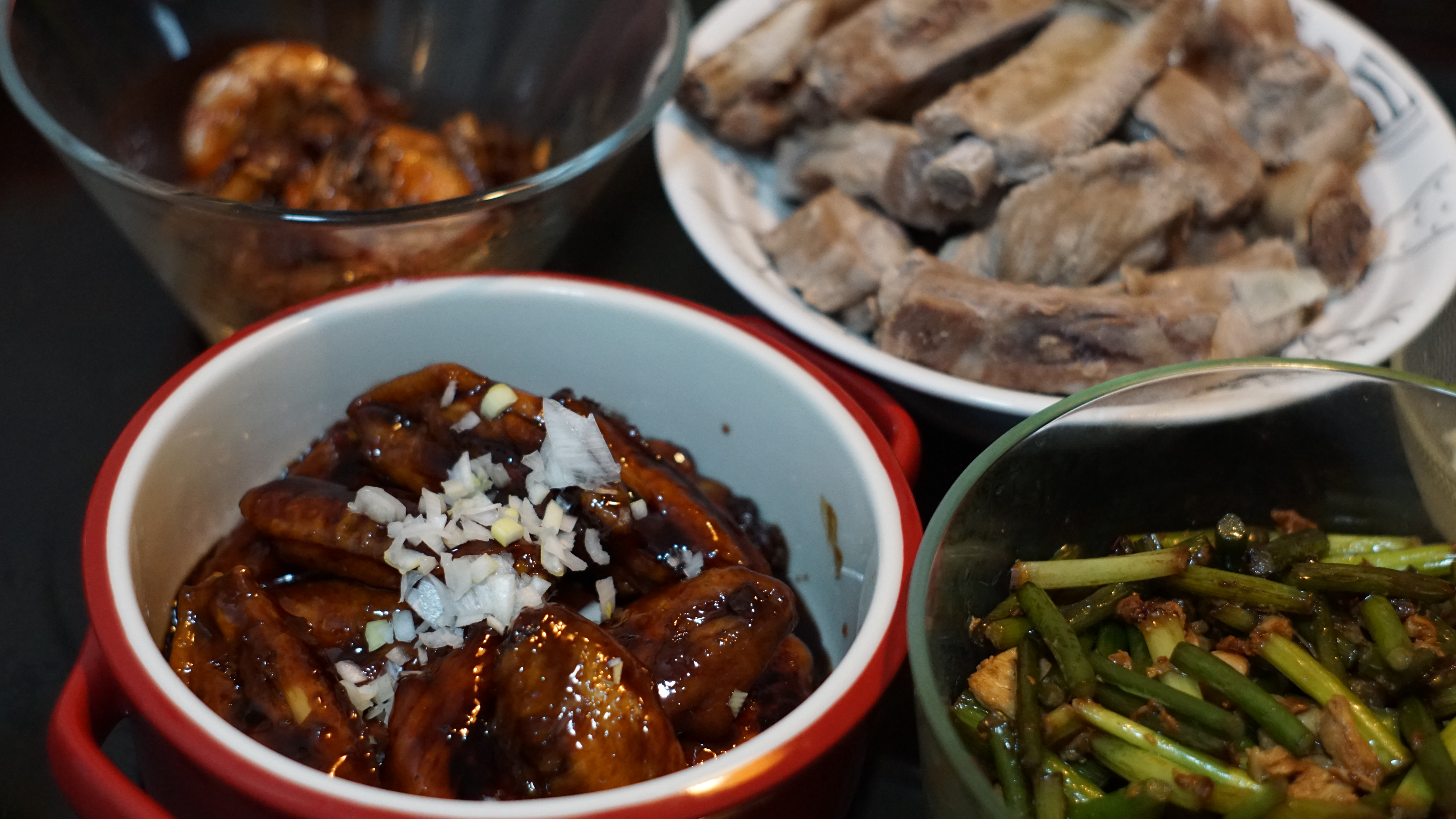
With the pandemic very much still with us, and new variants threatening to derail holiday festivities, many Chinese around the world will be unable to make the trip home during the Spring Festival. For those who will miss this all-important tradition in which families reunite with hugs and tears after a year apart, making a familiar dinner is one way to sate nostalgia.
China's cuisines are as diverse as its expansive country and population. From Peking duck to Cantonese wonton, from Sichuan hot pot to Shandong's cuttlefish roe soup, each dish is linked to a past, a custom, an inheritance.
Each flavor is a memory of family and home. Be it a plain bowl of congee or a lavish, elaborate feast, it offers a sense of belonging at a time when people continue to live in uncertainty and isolation. A comforting meal on the eve of the Spring Festival is nothing short of magical.
We've collected stories in which people can't make it home for the family holiday and plan to cook for themselves or their nuclear families to get a taste of home as the pandemic rages on. This is part one of our two-part series. Look out for part two.
Zhong Weimin, 58, professor, in Beijing, China
I was born in a village called Gangchengtun in eastern Shandong in 1963 and came to Beijing to study 40 years ago. Hunger defined my childhood. In that age of scarcity, I ate sweet potatoes three meals a day, I didn't know what a banana looked like before I reached 15, and rice was a luxury that only women who had just given birth could have.
Only on the eve of the Spring Festival could I have a fuller meal. One of the dishes most families in Shandong would do is fried flour dough with napa cabbage, also known as Chinese cabbage, and carrots. Since we usually couldn't afford the ingredients, our parents would prepare a lot so that we could eat our fill. Till today, fried dough has become an established tradition on Spring Festival Eve for people with roots in Shandong. When material conditions were changing for the better, salted beltfish, fried pork slices and crispy stuffed lotus root sandwiches were added to the "menu" of our dinner on Lunar New Year's Eve.
There's an anecdote with the dish of crispy stuffed lotus root sandwiches. During my teenage years, my family could only buy at most one kilogram of meat, most of which was fatty pork because it could be made into lard that would last longer. The stuffing for this dish, therefore, was mostly napa cabbage mixed with deep fried meat residues. Since meat was a rarity, I could only eat a few of them. Once my father was afraid that I'd eat them on the sly, he hung them up on the roof beam, which was too high for me to reach at the time. However, I successfully took them down and put them directly in my pocket. Then I got my friends together and we enjoyed them, which were actually cold and hard now that I think about it. At the time, our eyes would light up with excitement upon seeing food and we'd do anything to get something to eat.
As time rolled on, we could have dumplings – with wheat flour as wrappers– but only on the Lunar New Year's Eve. In the following days, the wrappers were, again, made from sweet potato flour.
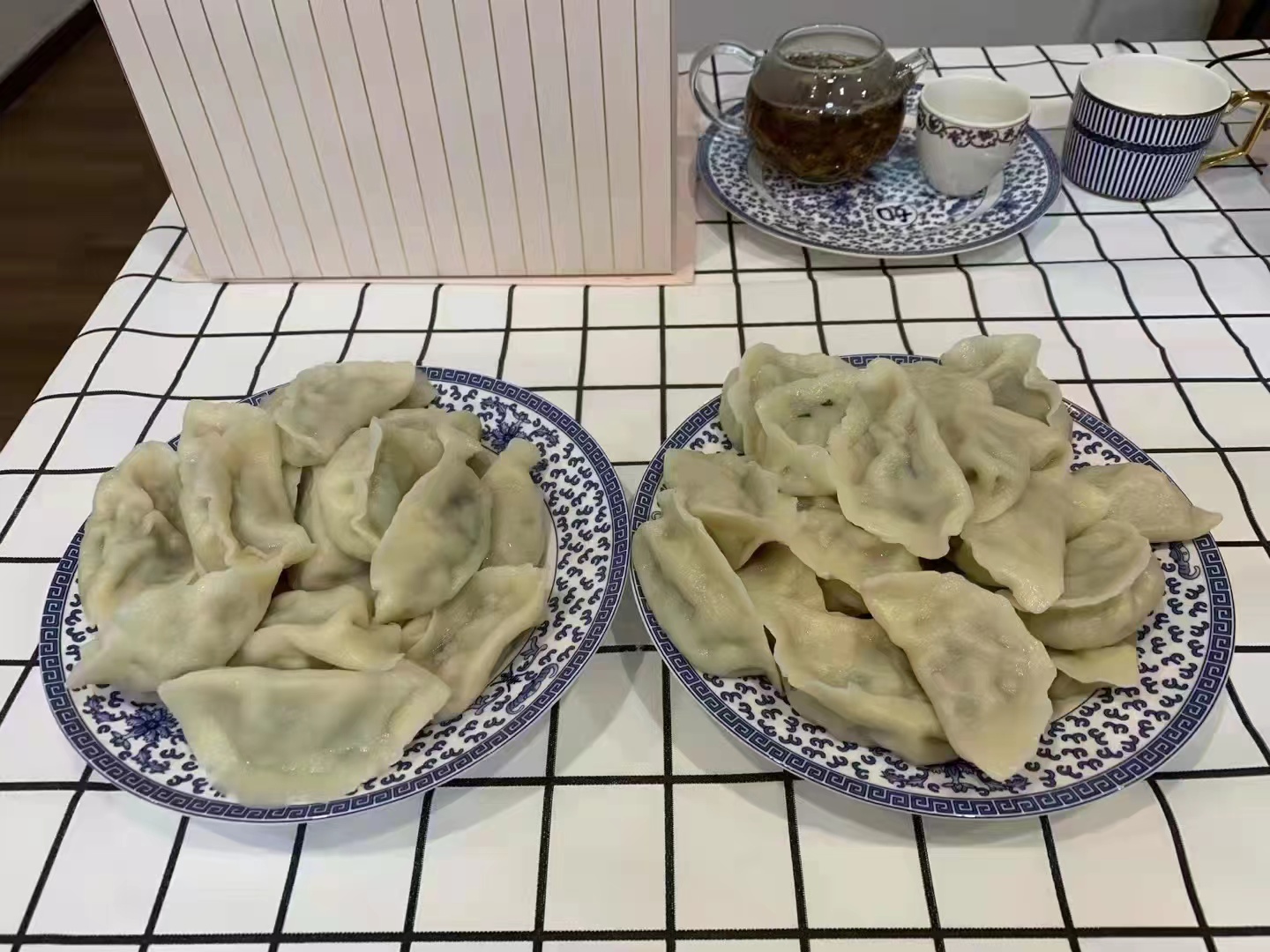
Dumplings are still a constant on the dinner table of Spring Festival Eves at Zhong's home. /Courtesy of Zhong
Dumplings are still a constant on the dinner table of Spring Festival Eves at Zhong's home. /Courtesy of Zhong
Now with abundant food of various kinds easy to get, the Spring Festival Eve dinner is no longer a luxury, or a longing.
Since I settled in Beijing, I haven't been home over the Spring Festival holiday for more than three decades. One reason is that my wife is the only child in her family and her parents live with us while my mother lives with my sister (my father passed away in my teens). For another, our old house in Gangchengtun was left unrepaired since no one lives there anymore and it's extremely cold during the winter. My mother lives with my sister's family in the city of Qingdao. Hence for me, there's no longer the concept of "going home," and over the years I have formed the habit of visiting my mother in Qingdao every summer holiday,
For me, one way to go back to the old days is by making a familiar dish. In addition to the crispy stuffed lotus root sandwiches, I like a cold dish that doesn't even have a proper name – tofu skin with leek.
Recipe:
First and foremost, you must find Shandong tofu skin, made with brine and special condiments. It's soft and fluffy and you can eat it directly.
Cut the tofu skin sheets crosswise into slices, and cut the stalk of the leek into slices too.
Mix them together with some vinegar, soy sauce and sliced garlic.
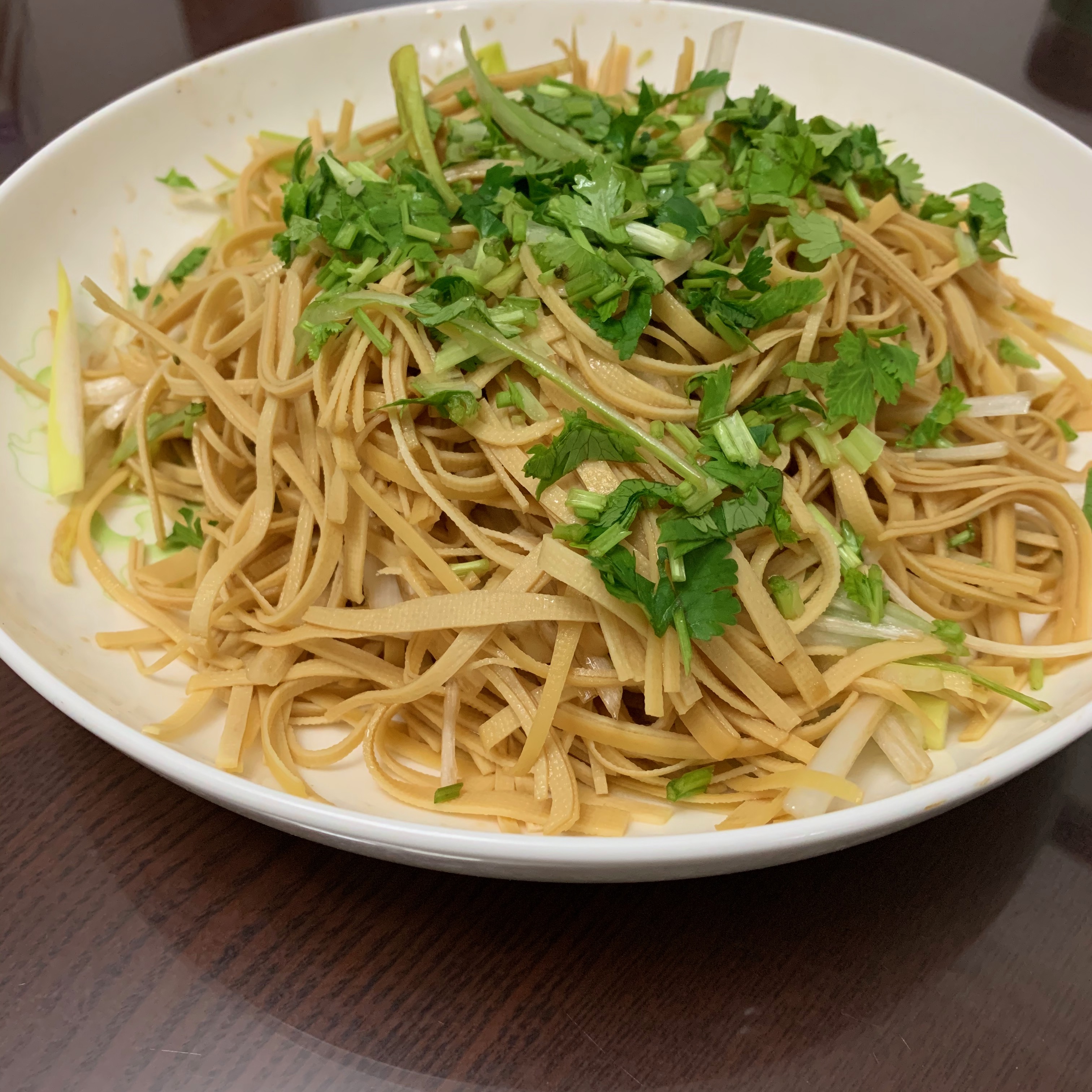
At home in Beijing, Zhong often makes tofu skin with leek, which reminds him of his hometown. /courtesy of Zhong
At home in Beijing, Zhong often makes tofu skin with leek, which reminds him of his hometown. /courtesy of Zhong
Guo Shangmin, 31, PhD student, in Edinburgh, UK
I've been in the UK for three and a half years, first studying for my master's and now pursuing a PhD degree at The University of Edinburgh. The last time I was home – a city called Dongying in east China's Shandong – was in early 2020, before the wide outbreak of the pandemic. A few days later news came that Wuhan entered a lockdown. I was lucky in that I made it home right before travel restrictions were imposed. Many other overseas students just missed the chance.
I'm a foodie and I like cooking. On the last Spring Festival Eve, my girlfriend and I invited several friends and prepared a few heavy dishes including a roasted slab of pork. We made dumplings while watching the Spring Festival Gala which aired in the afternoon in the UK due to the time difference. We filled the dumplings with two classic combinations – pork accented with napa cabbage, and, beef sauteed with onion. Actually, I like dumplings with chives the most, but chives in the UK are too expensive. Usually, 0.1 kilogram of chives costs the same as 0.5 kilograms of pork.
But I'm thinking of stuffing chives along with pork into pan-fried buns for this year's Spring Festival. Pan-fried buns filled with chives and pork are a local delicacy in Shandong and Henan provinces and a classic in my childhood.
When I was little, I lived with my maternal grandparents in a village. Back then, an elderly man shouldering a pole with two baskets on each end would come to the village a few days every week. The pan-fried buns were put in the baskets under a quilt to keep warm and sold for several cents each. I'd usually ask my grandfather for a few bucks when I heard the seller yelling and buy a couple of buns. The elderly man would carefully wrap the buns in old newspapers and hand them to me. The buns were fluffy, crispy on the outside, with fresh, juicy fillings inside.
I reached school age and moved back to the city to live with my parents but when I returned to visit my grandparents, the elderly peddler was no longer there. In the city, pan-fried buns thrived in a small diner with two or three pans lying inside and the buns were no longer wrapped in papers but laid flat on a peony-pattern, enamel tray. (Peonies were the most common pattern on kitchenware at the time.) When I went to high school, pan-fried buns were featured in a fancy restaurant as roadside diners were almost gone. The restaurant, though, closed down after a few years.
As time rolled on, I went to university in another city, always missing the buns. My mother, to my surprise, regularly went to a pan-fried bun bistro with an open kitchen so that she could see the whole cooking process. She remembered all that in mind and tried making the buns at home. It took her nearly half a year to develop her culinary skills in making pan-fried buns filled with pork and chives. Since then my backpack I carried from home to college at the end of my summer and winter holidays was full of pan-fried buns my mother made for me.
Days ago, an old friend from university asked when I'm going back because he missed the buns so much but he felt "ashamed" to go to my home alone to eat. He used to go with me to my home to eat the buns before I came to study in the UK.
As the pandemic unfurls, it seems that I can't go home any time soon, so for the dinner on Spring Festival Eve, I'd like to try making the buns myself. For me, the pan-fried buns are also nostalgic for my memories.
It's hard to find a proper griddle in Scotland. It needs to be non-stick, big enough and 10-centimeter deep since the bun is around 10 centimeters square. There's no such pan in cookware markets here so I may have to use a cast-iron skillet I use for cooking steaks.
Recipe: Patience.
The whole process from kneading dough and rolling it into wrappers, chopping meat, making the fillings, to frying on proper heating takes more than an hour.
Always watch the heat since the bottom of the bun can easily get burnt.
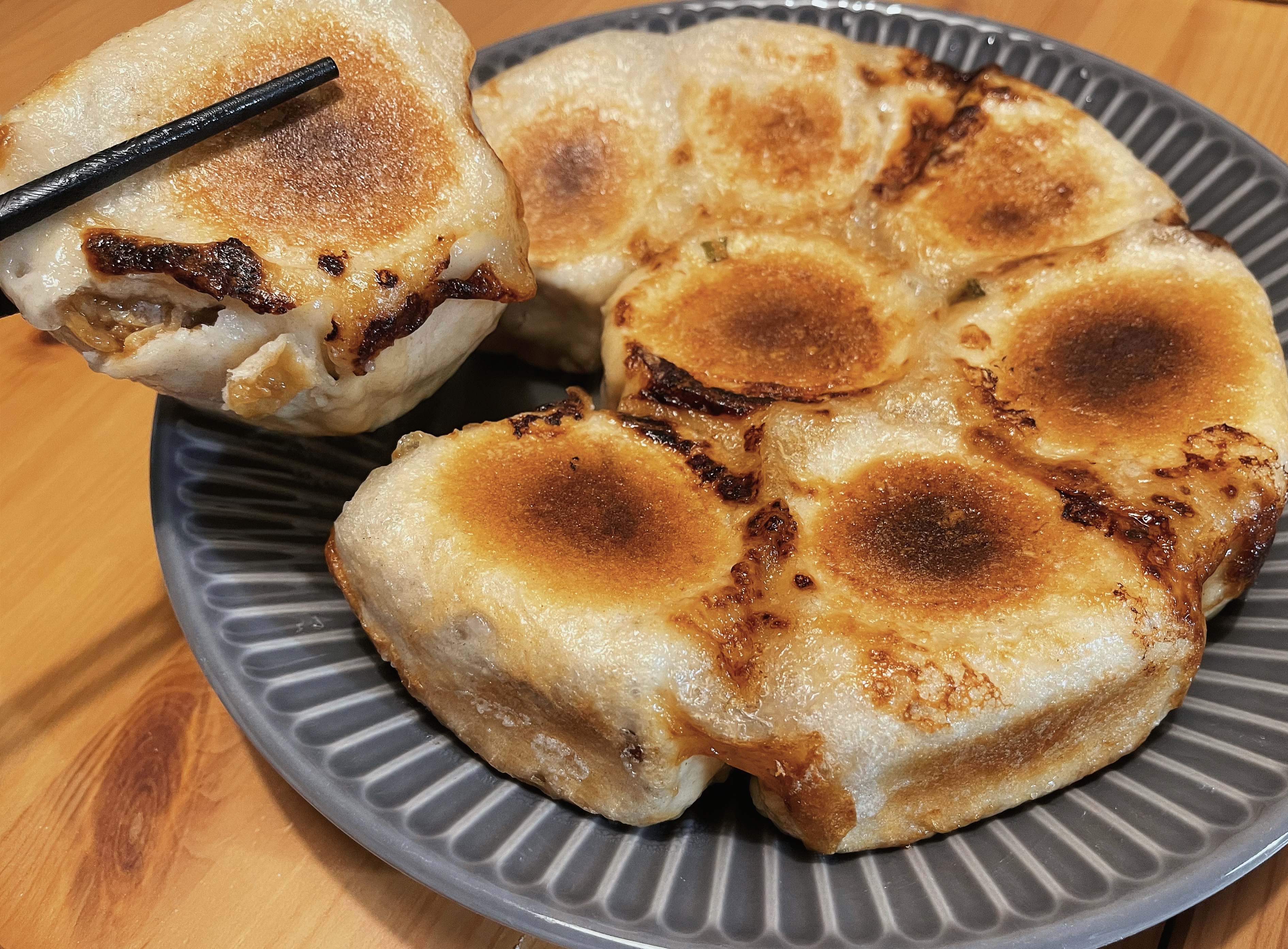
The pan-fried buns Guo made for the first time in the UK, on January 29, 2022 /courtesy of Guo
The pan-fried buns Guo made for the first time in the UK, on January 29, 2022 /courtesy of Guo
Liu Xincong, 27, editor, in Beijing, China
My home is in Shenyang, northeastern Liaoning. I wasn't home for last year's Spring Festival and I still can't make it this time. But I live with my two cousins in Beijing, so I won't be very lonely. We cook a lot because we find that most northeastern Chinese cuisines in Beijing are not that authentic. We plan to make a big feast on the eve of the Spring Festival, like we always had at our grandparents' house.
Since I could remember, my grandmother was the chef for the reunion dinner of this family holiday. She would cook a dozen dishes including steamed fish, braised prawns, fried chicken cutlets, spring rolls and various vegetables either stir-fried or tossed with dressing. Stuffed, we'd cleanse our palates with canned peaches she had made days before.
I spent a lot of time with my grandparents when I was little. My parents and I lived across the street from them, so I usually went directly to them after school. I clearly remember that I ate a plate of stir-fried garlic shoots with pork to go with a bowl of rice.
00:11
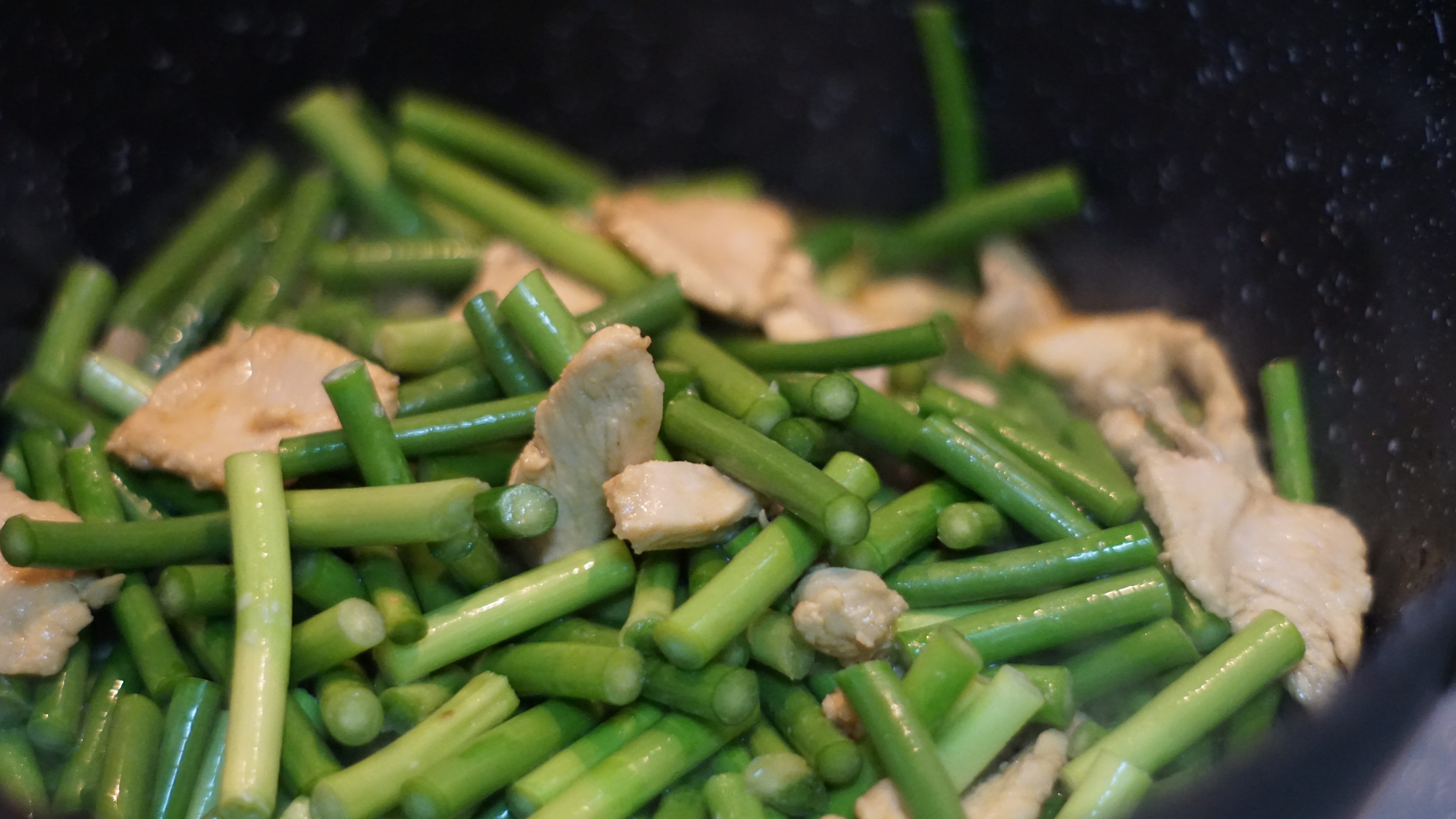
When I grew up, I realized I'd never cooked a meal for my grandma, who's almost 80 years old now. My grandpa passed away last spring and I think she's been through a lot. When the pandemic subsides, I want to go home more often to stay with her.
For the upcoming Spring Festival, preparing a feast and video chatting with my grandma and the bigger family should be a way to celebrate in the time of the pandemic. For dinner on Lunar New Year's Eve, I'd like to make braised prawns, a constant on my grandma's dining table during the most important family holiday.
Recipe:
Cut off the whiskers and claws of the prawns, remove the dark intestine from the top, and clean the prawns.
Turn on the stove and heat the oil, put the prawns in the pan, remember to use a spatula to squeeze out the red juice from the prawn heads.
Fry chopped ginger, leek and scallions, put the prawns in and season with a little oyster sauce, light soy sauce, salt and sugar.
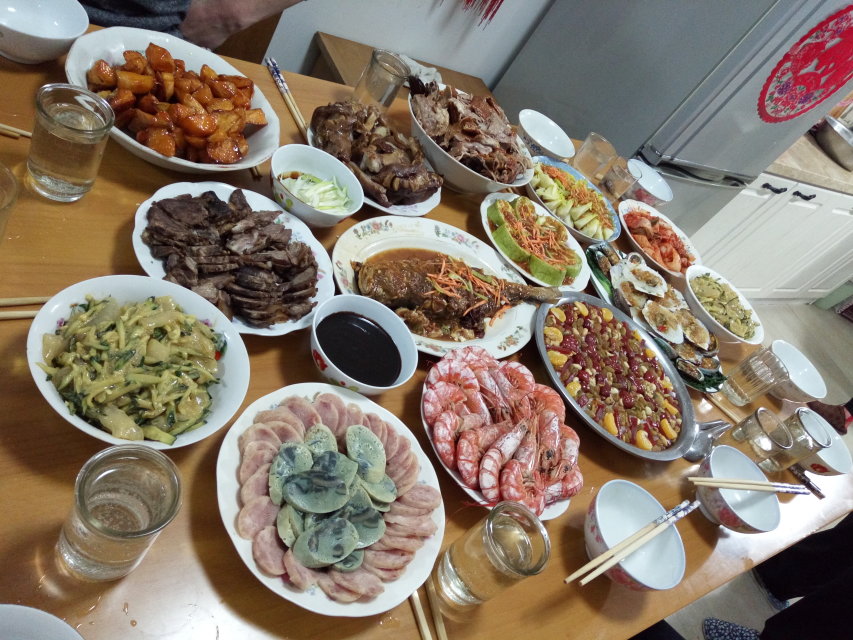
The dinner table on the eve of 2021 Spring Festival at Liu's family home in Shenyang, northeast China's Liaoning Province. /courtesy of Liu Xincong
The dinner table on the eve of 2021 Spring Festival at Liu's family home in Shenyang, northeast China's Liaoning Province. /courtesy of Liu Xincong
Kerry, 26, digital marketer, Shanghai, China
I'm from a Hakka family in Nankang District, Ganzhou, east China's Jiangxi. Roughly 99 percent of Nankang residents are Hakka people, who migrated to the south of the country amid the turmoil of war in the late 1800s and early 1990s. My family's ancestors could have come from central Henan Province.
However, the Hakka people developed a cooking style of their own, called Hakka cuisine. We'll have almost all the specialty dishes on the dining table at Spring Festival Eve, including little dried anchovies fried with pickles, preserved taro fried with duck gizzard, steamed pork with glutinous rice wrapped in broad lotus leaves, fish soup boiled with fried carp balls among others. All these traditional dishes have a bold flavor – oily, salty and spicy.
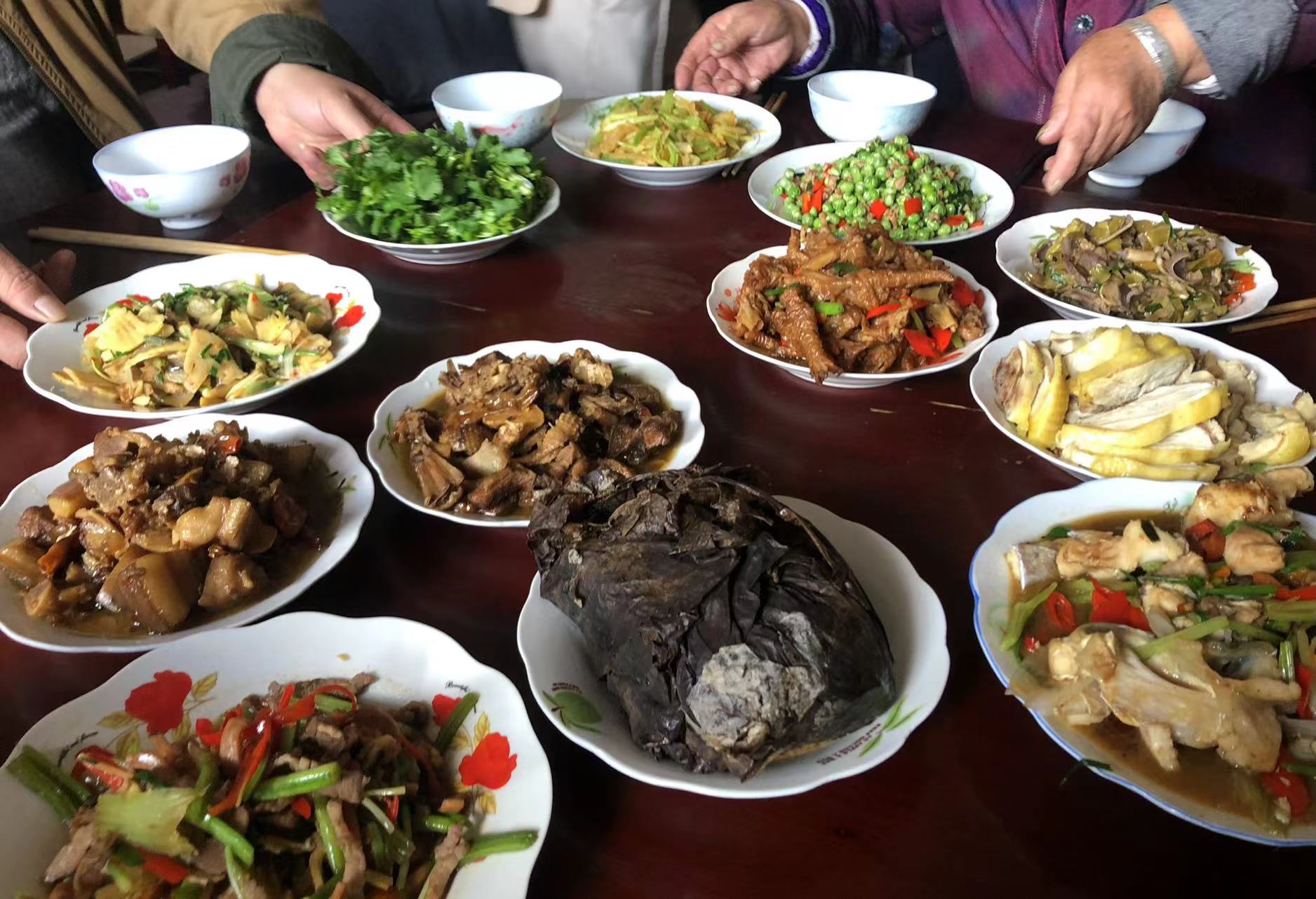
A Hakka cuisine dinner on the eve of the 2019 Spring Festival at Kerry's family home in Ganzhu, east China's Jiangxi Province. /courtesy of Kerry
A Hakka cuisine dinner on the eve of the 2019 Spring Festival at Kerry's family home in Ganzhu, east China's Jiangxi Province. /courtesy of Kerry
I've been working and living in Shanghai for five years. Before the Covid-19 outbreak, I'd go back home a couple of times every year. In the beginning, the only transportation route was a train that would be 14-15 hours one way. Later came direct flights that only took three hours. Every time I left for Shanghai, my grandma would give me a glass jar of little dried anchovies. She knows it's my favorite. In Shanghai, it's impossible to buy the same dried anchovies because my grandma singled out, dried and fried the anchovies herself.
Because of the pandemic, I didn't return home over the 2021 Lunar New Year holiday and can't do so for the upcoming Spring Festival either. I'm very close to my grandparents. When I called them last Spring Festival, I cried upon hearing their voices. Though I have quite a few cousins who can go back to spend family time with them, they still lament it's not a real reunion now that I'm away.
For dinner on Spring Festival Eve, I'll make little dried anchovies fried with pickles, which I cook often but could never get to the exact flavor of my grandma's.
00:25
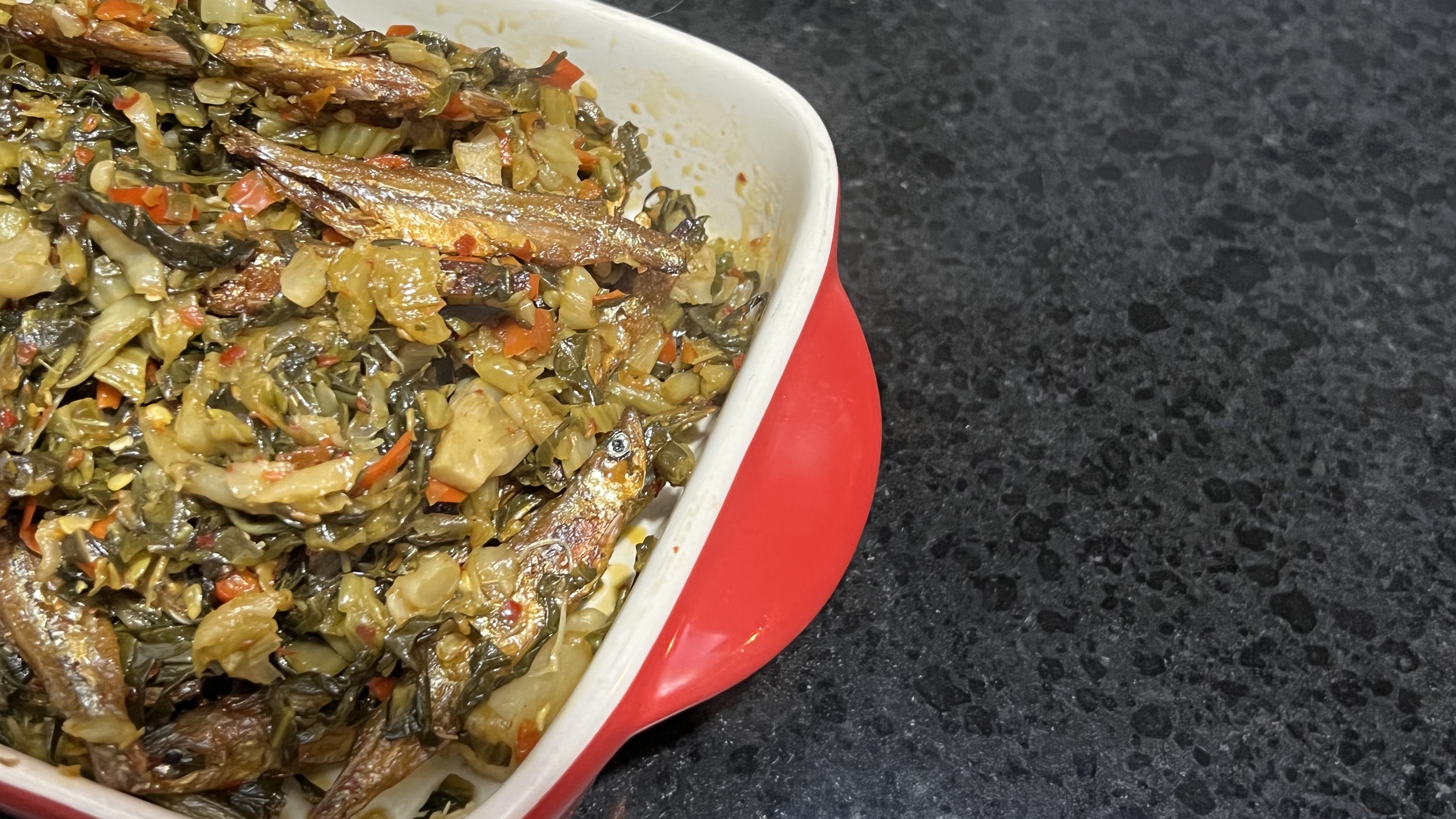
Recipe:
Buy some pickles online – type in "pickle" and "Jiangxi," browse the long list that pops up, and select the one that looks like my hometown's pickle the most.
Get some little dried anchovies, even though they are always bigger than my grandma's.
Stir fry the pickles until the excess water is absorbed and put them out on a plate. Put oil again and toss in the little dried anchovies.
Give the anchovies a deep-fry and pour the pickles in.
Add some chilis at the end. Remember not to add salt since the pickles are already briny.
(Zhong Xia contributed to reporting.)
(Cover image courtesy of Liu Xincong.)

